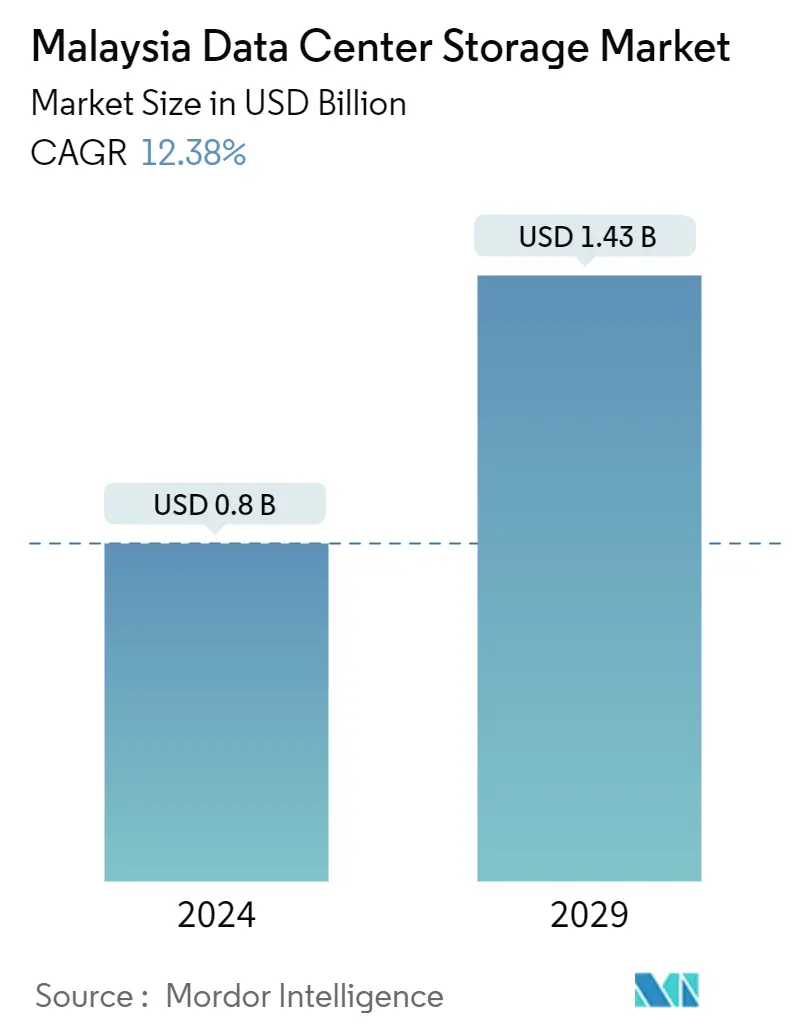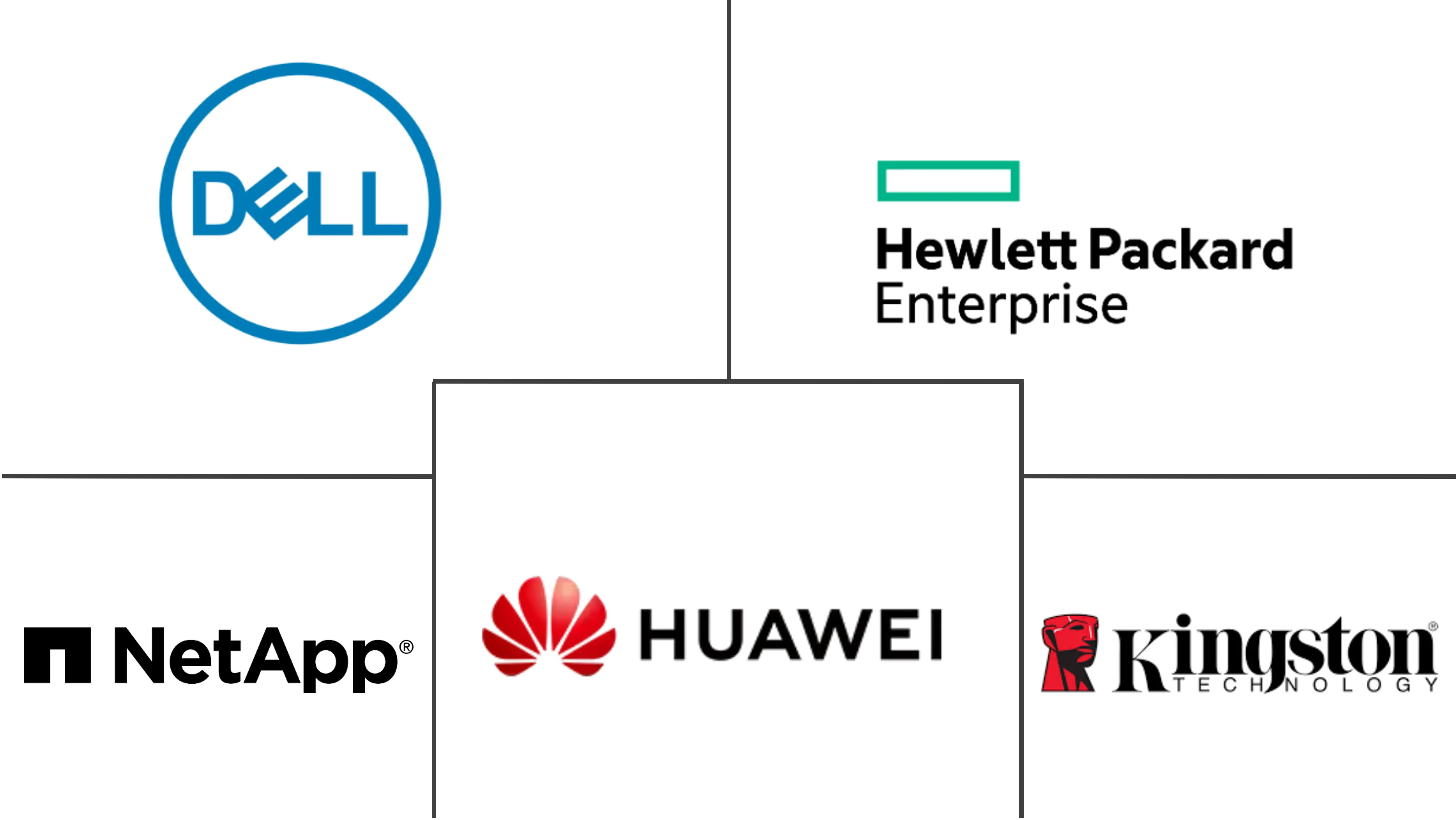Market Size of Malaysia Data Center Storage Industry

| Study Period | 2018 - 2029 |
| Base Year For Estimation | 2023 |
| Market Size (2024) | USD 0.8 Billion |
| Market Size (2029) | USD 1.43 Billion |
| CAGR (2024 - 2029) | 12.38 % |
| Market Concentration | Medium |
Major Players
*Disclaimer: Major Players sorted in no particular order |
Malaysia Data Center Storage Market Analysis
The Malaysia Data Center Storage Market size is estimated at USD 0.8 billion in 2024, and is expected to reach USD 1.43 billion by 2029, growing at a CAGR of 12.38% during the forecast period (2024-2029).
The increasing demand for cloud computing among SMEs, government regulations for local data security, and growing investment by domestic players are some of the major factors driving the demand for data centers in the country, leading to a growing need for data center storage equipment.
- Under Construction IT Load Capacity: The upcoming IT load capacity of the Malaysia data center market is expected to reach 1,300 MW by 2029.
- Under Construction Raised Floor Space: The country's construction of raised floor area is expected to increase by more than 7.5 million sq. ft by 2029.
- Planned Racks: The country's total number of racks to be installed is expected to reach 380K units by 2029. Cyberjaya-Kuala Lumpur is expected to house the maximum number of racks by 2029.
- Planned Submarine Cables: There are close to 25 submarine cable systems connecting Malaysia, and many are under construction. One such submarine cable that is estimated to start service in 2025 is SeaMeWe-6, which stretches over 19,200 Kilometers with landing points from Morib, Malaysia.
Malaysia Data Center Storage Industry Segmentation
Data center storage encompasses devices, hardware, networking equipment, and software technologies facilitating the storage of data and applications within data center facilities, used for storing, managing, retrieving, distributing, and backing up digital information within such facilities.
The Malaysia data center storage market is segmented by storage technology (network attached storage (NAS), storage area network (SAN), direct attached storage (DAS), and other technologies), by storage type (traditional storage, all-flash storage, and hybrid storage), and by end-user (IT & telecommunication, BFSI, government, media & entertainment, and other end-users).
Market sizes and forecasts are provided in terms of value (USD) for all the segments above
| Storage Technology | |
| Network Attached Storage (NAS) | |
| Storage Area Network (SAN) | |
| Direct Attached Storage (DAS) | |
| Other Technologies |
| Storage Type | |
| Traditional Storage | |
| All-Flash Storage | |
| Hybrid Storage |
| End-User | |
| IT & Telecommunication | |
| BFSI | |
| Government | |
| Media & Entertainment | |
| Other End-Users |
Malaysia Data Center Storage Market Size Summary
The Malaysia data center storage market is experiencing significant growth, driven by the increasing demand for cloud computing, government regulations on data security, and substantial investments by local players. The surge in digital services has led to a rise in data generation and processing, necessitating the expansion of data center storage infrastructure. This expansion is further fueled by the need for hyperscale facilities by major internet providers to support their cloud services. The government's initiatives, such as the Jendela program, aim to enhance fiber network coverage and 4G connectivity, which in turn supports the growth of data centers and the demand for storage devices. The telecommunications sector's expansion, driven by increased smartphone usage and the adoption of 5G networks, also contributes to the rising need for data center storage equipment.
The market is characterized by a semi-fragmented landscape with major players like Dell Inc., Hewlett Packard Enterprise, NetApp Inc., Huawei Technologies Co. Ltd., and Kingston Technology Company Inc. leading the charge. These companies are actively engaging in strategic collaborations to enhance their market presence and profitability. The adoption of hybrid storage solutions, which combine the speed of SSDs with the capacity of hard drives, is on the rise, driven by the need for flexibility and scalability in data storage. Partnerships, such as Pure Storage's collaboration with Westcon-Comstor, aim to accelerate the adoption of advanced storage solutions. The continuous evolution of storage technologies and the integration of hybrid solutions are expected to play a crucial role in shaping Malaysia's data infrastructure landscape, addressing the growing connectivity demands across industries.
Malaysia Data Center Storage Market Size - Table of Contents
-
1. Market Dynamics
-
1.1 Market Overview
-
1.2 Market Drivers
-
1.2.1 Expansion of IT Infrastructure to Increase Market Growth
-
1.2.2 Increased Investments in Hyperscale Data Centers To Increase Market Growth
-
-
1.3 Market Restraints
-
1.3.1 High Initial Investment Cost To Hinder Market Growth
-
-
1.4 Value Chain / Supply Chain Analysis
-
1.5 Industry Attractiveness - Porter's Five Forces Analysis
-
1.5.1 Threat of New Entrants
-
1.5.2 Bargaining Power of Buyers/Consumers
-
1.5.3 Bargaining Power of Suppliers
-
1.5.4 Threat of Substitute Products
-
1.5.5 Intensity of Competitive Rivalry
-
-
1.6 Assessment of COVID-19 Impact
-
-
2. MARKET SEGMENTATION
-
2.1 Storage Technology
-
2.1.1 Network Attached Storage (NAS)
-
2.1.2 Storage Area Network (SAN)
-
2.1.3 Direct Attached Storage (DAS)
-
2.1.4 Other Technologies
-
-
2.2 Storage Type
-
2.2.1 Traditional Storage
-
2.2.2 All-Flash Storage
-
2.2.3 Hybrid Storage
-
-
2.3 End-User
-
2.3.1 IT & Telecommunication
-
2.3.2 BFSI
-
2.3.3 Government
-
2.3.4 Media & Entertainment
-
2.3.5 Other End-Users
-
-
Malaysia Data Center Storage Market Size FAQs
How big is the Malaysia Data Center Storage Market?
The Malaysia Data Center Storage Market size is expected to reach USD 0.8 billion in 2024 and grow at a CAGR of 12.38% to reach USD 1.43 billion by 2029.
What is the current Malaysia Data Center Storage Market size?
In 2024, the Malaysia Data Center Storage Market size is expected to reach USD 0.8 billion.

